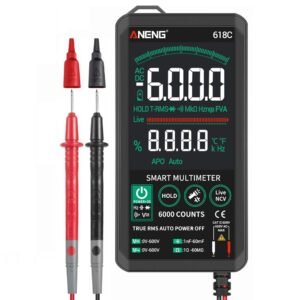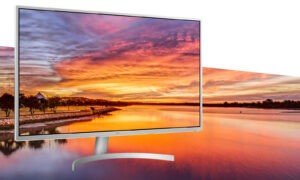
As an industry professional with over 12 years of experience in the LCD sector, I’m often asked whether AMOLED technology can replace LCD in various applications. The answer isn’t as straightforward as it might seem. It’s not simply about one technology being “better” than the other; rather, it depends on the specific needs of your product, the application, and cost considerations. Below, I’ll break down the key factors to consider and provide real-world examples, data, and insights to help make an informed decision.
1. Conclusion: Is AMOLED a Suitable Replacement for LCD?
In certain applications, AMOLED displays can indeed replace LCDs. However, this transition is not universal. AMOLED is ideal for high-end devices where display quality, power efficiency, and contrast are critical. Devices like smartphones, wearables, and premium TVs often benefit from AMOLED’s superior color reproduction, contrast ratio, and energy efficiency.
However, for cost-sensitive applications, industrial devices, and large-scale displays, LCD technology remains the more practical choice. LCDs are more affordable, longer-lasting, and better suited for applications where battery life and power efficiency aren’t as critical.
2. Technical Differences: AMOLED vs. LCD
AMOLED Display Technology:
-
- Self-Emissive Pixels: Each pixel in an AMOLED display emits its own light, leading to true blacks and better contrast ratios.
-
- Power Efficiency: AMOLED consumes less power when displaying dark content, as black pixels are turned off completely.
-
- Faster Response Time: Ideal for high-speed content like gaming and video.
LCD Display Technology:
-
- Backlit Pixels: LCDs require a backlight, meaning even black pixels are partially illuminated, resulting in lower contrast.
-
- Higher Brightness: LCD displays tend to be brighter overall, making them ideal for outdoor and bright environments.
-
- Cost-Effective: The cost of manufacturing an AMOLED display is significantly higher than LCD due to the more complex active matrix organic light-emitting diode (AMOLED) technology. However, if your business requires high-quality LCD display modules for devices like smartphones, wearables, explore our range of LCD and AMOLED display modules.
These technical differences highlight why AMOLED is typically favored for premium, high-performance devices, while LCD remains the go-to choice for more budget-conscious and industrial applications.
3. Real-World Performance: Application Scenarios
Smartphones:
In high-end smartphones, AMOLED has become the display technology of choice. For example:
-
- Samsung Galaxy S23 Ultra: Uses Dynamic AMOLED 2X technology with a peak brightness of 1,750 nits. The result is exceptional contrast, color vibrancy, and efficiency.
-
- Apple iPhone 15 Pro: While not strictly AMOLED, it uses OLED, a form of AMOLED, delivering similar benefits in battery efficiency (up to 30% less power consumption than traditional LCD) and superior color accuracy.
In contrast, budget smartphones often still use LCDs, like Samsung’s A-series or Xiaomi’s budget models, where cost is more of a consideration than premium display features.
Wearables:
For wearables such as smartwatches, AMOLED is often the preferred choice due to its energy efficiency. For example:
-
- Fitbit Sense 2: This device uses an AMOLED display and boasts up to 6 days of battery life due to the lower power consumption of AMOLED, particularly when displaying dark interfaces or backgrounds.
On the other hand, LCD is commonly used in simpler devices where battery life isn’t a concern, such as in older or budget-friendly fitness trackers.
TVs and Large Displays:
In premium TVs, OLED technology (which is essentially AMOLED) provides superior contrast and color accuracy. For instance, LG’s OLED TV series is renowned for its ability to deliver perfect blacks and unmatched contrast ratios, creating a more immersive viewing experience. However, LCD TVs remain dominant in the mainstream market, particularly in larger screen sizes where costs can be kept lower without compromising display quality too much. For example, a 55-inch 4K LCD TV can be significantly cheaper than a similar-sized OLED TV.
For example, our display modules are used in a wide variety of industries. Discover how our modules perform in real-world applications, from automotive displays to wearable devices.
4. Cost Considerations: Production and Long-Term Expenses
While AMOLED offers better visual performance, it also comes at a higher production cost. Here’s a breakdown:
AMOLED Cost:
The cost of manufacturing an AMOLED display is significantly higher than LCD due to the more complex active matrix organic light-emitting diode (AMOLED) technology. According to a 2022 IHS Markit report, the cost of producing a 6-inch AMOLED panel can range from $40 to $45, whereas a comparable 6-inch LCD panel costs around $15 to $20. The higher cost is attributed to the use of organic materials and more precise fabrication processes.
LCD Cost:
LCD displays, in contrast, are far more cost-effective, especially for mass-market applications. LCDs have been in production for decades, making the technology well-established and scalable. For many devices, particularly budget smartphones, tablets, and large-format displays, the cost-saving benefits of LCD cannot be overlooked.
Long-Term Maintenance:
While the initial cost of AMOLED is higher, it can offer long-term power savings. AMOLED displays consume up to 50% less power when displaying dark content compared to LCDs, which results in lower electricity consumption over time. For instance, a smartphone with an AMOLED screen will likely offer better battery performance than one with an LCD screen, especially under low-light conditions.
However, one downside of AMOLED technology is burn-in. AMOLED screens are susceptible to image retention if static images remain on the screen for prolonged periods. This can be a concern for devices like TVs or monitors where static elements (e.g., navigation bars or logos) are displayed for extended periods.
If you’re concerned about the long-term maintenance of LCD displays, our expert technical support ensures your products perform at their best throughout their lifecycle.
5. Challenges and Limitations of Switching from LCD to AMOLED
While switching from LCD to AMOLED seems appealing for certain applications, there are challenges:
-
- Manufacturing Complexity: AMOLED screens require advanced manufacturing techniques and more precise equipment. As a result, fewer manufacturers are capable of producing AMOLED panels at scale, especially in the larger sizes needed for TVs and monitors.
-
- Durability: AMOLED displays are more prone to degradation over time, particularly in outdoor applications where brightness and exposure to UV light can reduce their lifespan. In contrast, LCDs are more durable and can maintain their performance over longer periods. For manufacturers and distributors who require customized solutions, we offer custom display module services, including size and functionality adjustments to meet specific product requirements.
-
- Burn-In Risk: As mentioned earlier, AMOLED displays face the issue of burn-in, especially when displaying static content for extended periods. For businesses and consumers that need reliability in the long term (e.g., for signage or industrial uses), this could be a dealbreaker.
Conclusion: The Future of LCD and AMOLED Displays
In conclusion, while AMOLED technology offers significant advantages in terms of visual quality, power efficiency, and contrast, it is not yet a universal replacement for LCD technology. AMOLED is most suitable for premium consumer devices like smartphones, wearables, and high-end TVs where performance and power efficiency are top priorities. However, for applications requiring cost-effectiveness, durability, and longevity, such as industrial displays, large-screen TVs, and budget smartphones, LCD remains the preferred choice.
For manufacturers and distributors, it’s important to weigh the benefits of AMOLED against the higher costs and manufacturing complexities. If you’re targeting premium markets where users expect the best visual experience, AMOLED is a strong contender. However, for broader consumer markets and industrial sectors, LCD still holds a competitive edge.
With over 12 years of experience in the LCD industry, we offer reliable and cost-effective display solutions tailored to your business needs. Learn more about our company and expertise.
Sources:
- Samsung Display, 2023. “AMOLED vs. LCD: Key Advantages in Performance and Efficiency.”
- IHS Markit, 2022. “Cost Breakdown of AMOLED vs. LCD Panels.”
- Consumer Reports, 2019. “AMOLED vs. LCD: Durability and Performance in TVs.”
- NPD DisplaySearch, 2022. “Energy Efficiency and Power Consumption Comparison.”




